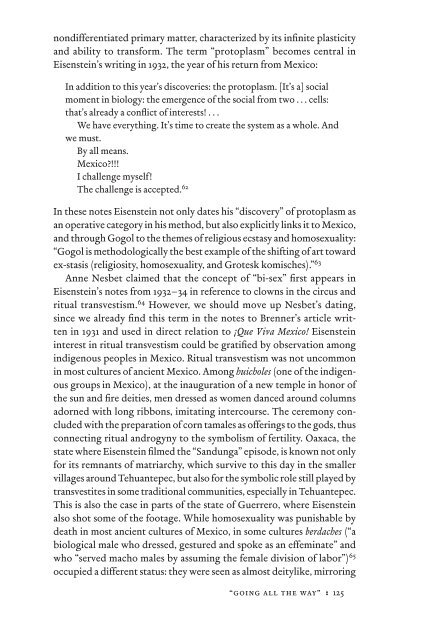In Excess: Sergei Eisentein's Mexico - Cineclub
In Excess: Sergei Eisentein's Mexico - Cineclub
In Excess: Sergei Eisentein's Mexico - Cineclub
Create successful ePaper yourself
Turn your PDF publications into a flip-book with our unique Google optimized e-Paper software.
nondifferentiated primary matter, characterized by its infi nite plasticity<br />
and ability to transform. The term “protoplasm” becomes central in<br />
Eisenstein’s writing in 1932, the year of his return from <strong>Mexico</strong>:<br />
<strong>In</strong> addition to this year’s discoveries: the protoplasm. [It’s a] social<br />
moment in biology: the emergence of the social from two . . . cells:<br />
that’s already a confl ict of interests! . . .<br />
We have everything. It’s time to create the system as a whole. And<br />
we must.<br />
By all means.<br />
<strong>Mexico</strong>?!!!<br />
I challenge myself!<br />
The challenge is accepted. 62<br />
<strong>In</strong> these notes Eisenstein not only dates his “discovery” of protoplasm as<br />
an operative category in his method, but also explicitly links it to <strong>Mexico</strong>,<br />
and through Gogol to the themes of religious ecstasy and homosexuality:<br />
“Gogol is methodologically the best example of the shifting of art toward<br />
ex-stasis (religiosity, homosexuality, and Grotesk komisches).” 63<br />
Anne Nesbet claimed that the concept of “bi-sex” fi rst appears in<br />
Eisenstein’s notes from 1932–34 in reference to clowns in the circus and<br />
ritual transvestism. 64 However, we should move up Nesbet’s dating,<br />
since we already fi nd this term in the notes to Brenner’s article written<br />
in 1931 and used in direct relation to ¡Que Viva <strong>Mexico</strong>! Eisenstein<br />
interest in ritual transvestism could be gratifi ed by observation among<br />
indigenous peoples in <strong>Mexico</strong>. Ritual transvestism was not uncommon<br />
in most cultures of ancient <strong>Mexico</strong>. Among huicholes (one of the indigenous<br />
groups in <strong>Mexico</strong>), at the inauguration of a new temple in honor of<br />
the sun and fi re deities, men dressed as women danced around columns<br />
adorned with long ribbons, imitating intercourse. The ceremony concluded<br />
with the preparation of corn tamales as offerings to the gods, thus<br />
connecting ritual androgyny to the symbolism of fertility. Oaxaca, the<br />
state where Eisenstein fi lmed the “Sandunga” episode, is known not only<br />
for its remnants of matriarchy, which survive to this day in the smaller<br />
villages around Tehuantepec, but also for the symbolic role still played by<br />
transvestites in some traditional communities, especially in Tehuantepec.<br />
This is also the case in parts of the state of Guerrero, where Eisenstein<br />
also shot some of the footage. While homosexuality was punishable by<br />
death in most ancient cultures of <strong>Mexico</strong>, in some cultures berdaches (“a<br />
biological male who dressed, gestured and spoke as an effeminate” and<br />
who “served macho males by assuming the female division of labor”) 65<br />
occupied a different status: they were seen as almost deitylike, mirroring<br />
“going all the way” : 125


